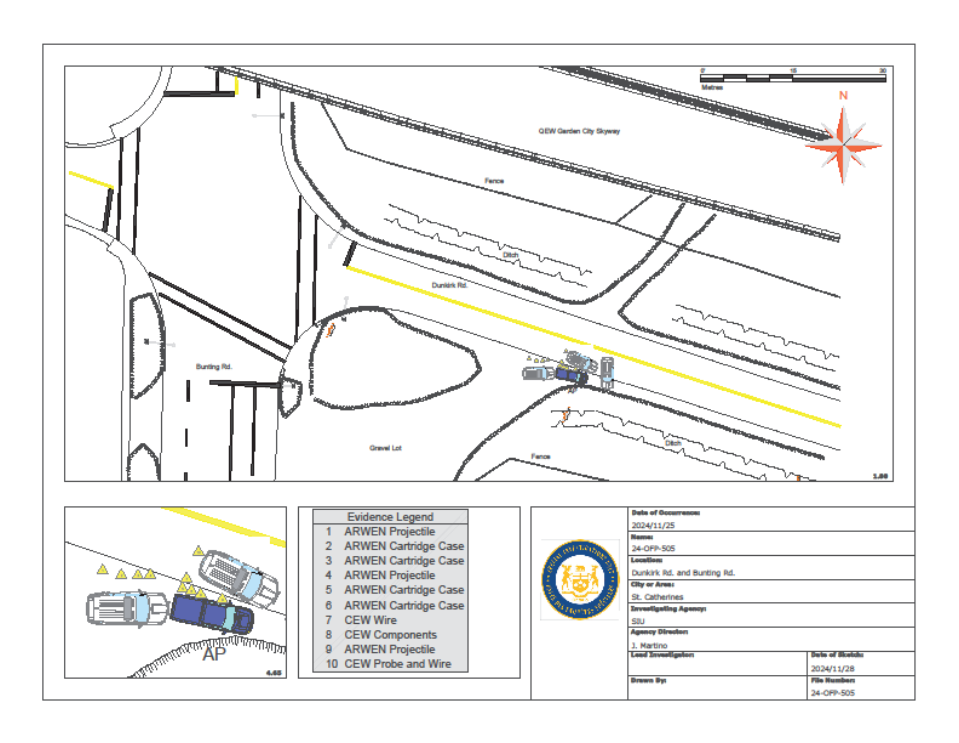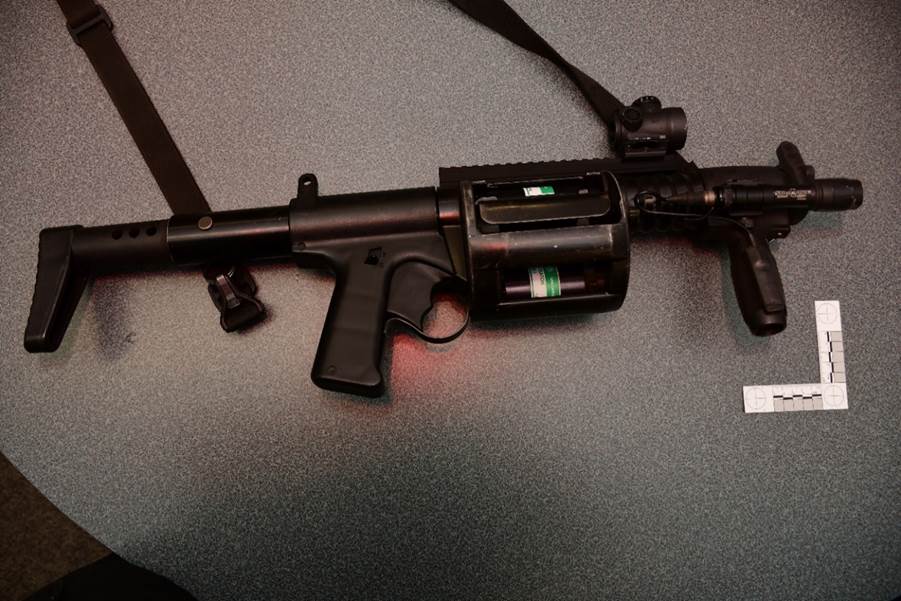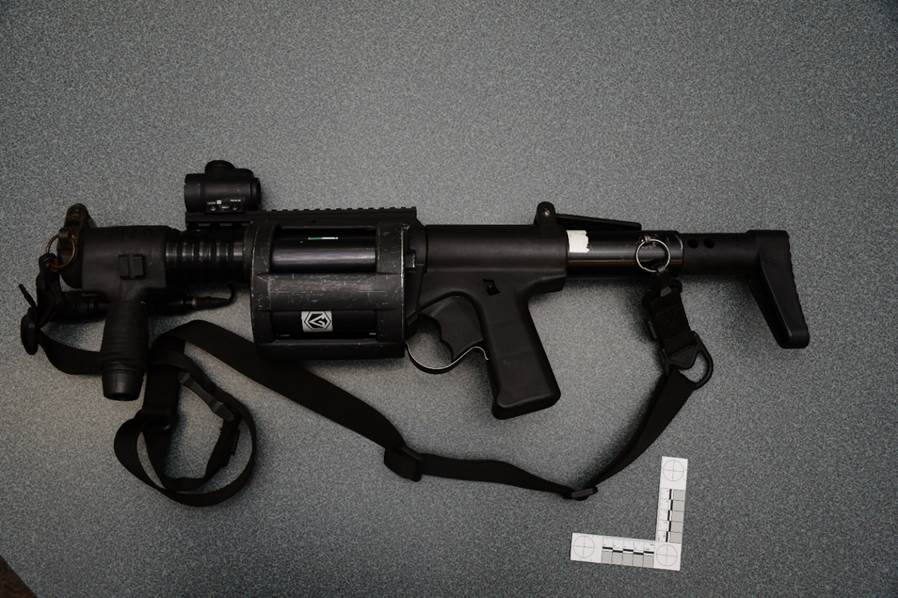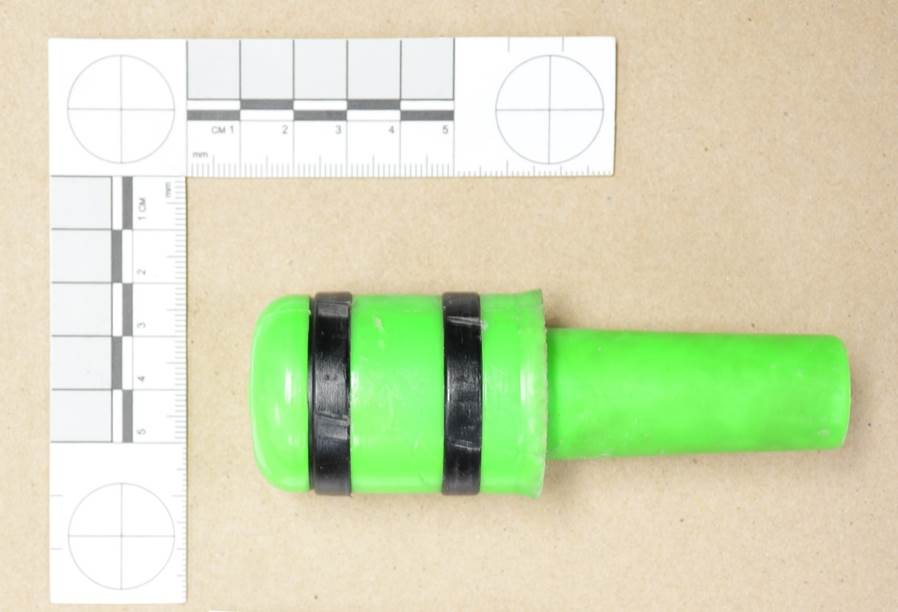SIU Director’s Report - Case # 24-OFP-505
Warning:
This page contains graphic content that can shock, offend and upset.
Contents:
Mandate of the SIU
The Special Investigations Unit is a civilian law enforcement agency that investigates incidents involving an official where there has been death, serious injury, the discharge of a firearm at a person or an allegation of sexual assault. Under the Special Investigations Unit Act, 2019 (SIU Act), officials are defined as police officers, special constables of the Niagara Parks Commission and peace officers under the Legislative Assembly Act. The SIU’s jurisdiction covers more than 50 municipal, regional and provincial police services across Ontario.
Under the SIU Act, the Director of the SIU must determine based on the evidence gathered in an investigation whether there are reasonable grounds to believe that a criminal offence was committed. If such grounds exist, the Director has the authority to lay a criminal charge against the official. Alternatively, in cases where no reasonable grounds exist, the Director cannot lay charges. Where no charges are laid, a report of the investigation is prepared and released publicly, except in the case of reports dealing with allegations of sexual assault, in which case the SIU Director may consult with the affected person and exercise a discretion to not publicly release the report having regard to the affected person’s privacy interests.
Information Restrictions
Special Investigations Unit Act, 2019
Pursuant to section 34, certain information may not be included in this report. This information may include, but is not limited to, the following:
- The name of, and any information identifying, a subject official, witness official, civilian witness or affected person.
- Information that may result in the identity of a person who reported that they were sexually assaulted being revealed in connection with the sexual assault.
- Information that, in the opinion of the SIU Director, could lead to a risk of serious harm to a person.
- Information that discloses investigative techniques or procedures.
- Information, the release of which is prohibited or restricted by law.
- Information in which a person’s privacy interest in not having the information published clearly outweighs the public interest in having the information published.
Freedom of Information and Protection of Personal Privacy Act
Pursuant to section 14 (i.e., law enforcement), certain information may not be included in this report. This information may include, but is not limited to, the following:
- Confidential investigative techniques and procedures used by law enforcement agencies; and
- Information that could reasonably be expected to interfere with a law enforcement matter or an investigation undertaken with a view to a law enforcement proceeding.
Pursuant to section 21 (i.e., personal privacy), protected personal information is not included in this report. This information may include, but is not limited to, the following:
- The names of persons, including civilian witnesses, and subject and witness officials;
- Location information;
- Witness statements and evidence gathered in the course of the investigation provided to the SIU in confidence; and
- Other identifiers which are likely to reveal personal information about individuals involved in the investigation.
Personal Health Information Protection Act, 2004
Pursuant to this legislation, any information related to the personal health of identifiable individuals is not included.
Other proceedings, processes, and investigations
Information may also have been excluded from this report because its release could undermine the integrity of other proceedings involving the same incident, such as criminal proceedings, coroner’s inquests, other public proceedings and/or other law enforcement investigations.
Mandate Engaged
Pursuant to section 15 of the SIU Act, the SIU may investigate the conduct of officials, be they police officers, special constables of the Niagara Parks Commission or peace officers under the Legislative Assembly Act, that may have resulted in death, serious injury, sexual assault or the discharge of a firearm at a person.
A person sustains a “serious injury” for purposes of the SIU’s jurisdiction if they: sustain an injury as a result of which they are admitted to hospital; suffer a fracture to the skull, or to a limb, rib or vertebra; suffer burns to a significant proportion of their body; lose any portion of their body; or, as a result of an injury, experience a loss of vision or hearing.
In addition, a “serious injury” means any other injury sustained by a person that is likely to interfere with the person’s health or comfort and is not transient or trifling in nature.
This report relates to the SIU’s investigation into the discharge of a firearm by the police at a 46-year-old man (the “Complainant”).
The Investigation
Notification of the SIU[1]
On November 25, 2024, at 2:15 p.m., the Niagara Regional Police Service (NRPS) contacted the SIU with the following information.
On November 25, 2024, at 11:59 a.m., the Complainant called 911 and reported he was armed with a knife and intended to kill himself. He stated he was parked on the shoulder of Dunkirk Road at Bunting Road, St. Catharines. NRPS officers arrived on scene and began negotiating with the Complainant, who was locked inside his pick-up truck. It was learned the Complainant suffered from schizophrenia, had stopped taking his medication, and was cutting his wrists. Mobile Crisis Rapid Response Team (MCRRT) officer, Witness Officer (WO) #1, arrived and spoke to the Complainant. Emergency Task Unit (ETU) officers, Subject Official (SO) #2 and SO #1, arrived soon after. At 1:59 p.m., the Complainant agreed to exit his pick-up truck, but then attempted to return to the vehicle. SO #2 and SO #1 discharged Anti-riot Weapon ENfield (ARWEN) firearms. WO #3 was also present, and he discharged a conducted energy weapon (CEW). The Complainant was apprehended under the Mental Health Act and transported via ambulance to Niagara Health – St. Catharines.
The Team
Date and time team dispatched: 2024/11/25 at 2:25 p.m.
Date and time SIU arrived on scene: 2024/11/25 at 4:10 p.m.
Number of SIU Investigators assigned: 3
Number of SIU Forensic Investigators assigned: 1
Affected Person (aka “Complainant”):
46-year-old male; interviewed
The Complainant was interviewed on November 25, 2024.
Subject Officials
SO #1 Declined interview, as is the subject official’s legal right; notes received and reviewed
SO #2 Declined interview, as is the subject official’s legal right; notes received and reviewed
Witness Officials
WO #1 Interviewed; notes received and reviewed
WO #2 Interviewed; notes received and reviewed
WO #3 Not interviewed; notes reviewed and interview deemed unnecessary
The witness officials were interviewed on December 4, 2024.
Evidence
The Scene
The events in question transpired in and around the gravel lot area on the southeast corner of the intersection of Dunkirk Road and Bunting Road, St. Catharines.
Scene Diagram

Physical Evidence
On November 25, 2024, at 4:10 p.m., SIU investigators arrived at the scene, which was protected by uniformed NRPS officers.
On the southeast corner of the intersection of Dunkirk Road and Bunting Road was a gravel lot area. The Complainant’s vehicle was on the south boulevard of Dunkirk Road, oriented eastbound. There were tire deflation devices positioned around the front and rear tires of his truck. The keys were in the ignition of the truck and both door windows were lowered partially. The truck was surrounded by NRPS vehicles. A small deposit of blood was obvious on the ground outside the driver’s door of the pick-up truck.
CEW wires and several ARWEN projectiles were recovered from the driver side of the Complainant’s pick-up truck. Also located nearby were a restraint shield and a collection of breaching tools.
On the driver side of the pick-up truck the SIU located three 37mm ARWEN projectiles and four ARWEN cartridge cases, along with CEW wires, four probes, and plastic CEW wire spacers.
One ARWEN projectile was unaccounted for and was believed to have landed in the thick brush near the fence south of Dunkirk Road.
Inside the vehicle, two paper coffee cups were in the centre cup holders, one of them with an open folding knife in it, oriented blade down. Blood staining was visible on the knife blade. There was also blood staining on the driver’s seat. Near the centre console was a cellular telephone.
Both ARWEN devices had been secured by the NRPS. They were examined by the SIU forensic investigator, and each was found to have two empty magazine chambers.

Figure 1 - SO #1’s ARWEN
Figure - SO #2’s ARWEN
 2
2
 EN Projectile">
EN Projectile">
Figure 3 - ARWEN Projectile
Forensic Evidence
CEW Deployment Data
The CEW data revealed WO #3 deployed both cartridges of his CEW at 1:52 p.m., November 25, 2024.[2]
Video/Audio/Photographic Evidence[3]
The communications recordings provided to the SIU documented the Complainant calling 911 four times on the morning of November 25, 2024. He expressed concern for the safety of his family members, but repeatedly grew frustrated with the 911 call-taker and disconnected.
At 11:58 a.m., the NRPS call-taker advised an ambulance dispatcher the NRPS had received a call from the Complainant who was sitting in a pick-up truck and cutting his wrists. The Complainant reported he did not have a lot of time left and he could barely move, as he had lost a lot of blood. The Complainant also reported he believed people were intent on harming his family.
Materials Obtained from Police Service
Upon request, the SIU obtained the following records from the NRPS between November 28, 2024, and January 13, 2025:
- Computer-aided Dispatch Report;
- Notes - WO #1;
- Notes - WO #2;
- Notes - WO #3;
- Notes - SO #1;
- Notes - SO #2;
- CEW deployment data - WO #3;
- Record Management System Report - the Complainant;
- Photograph of the Complainant seated in his vehicle; and
- Communications recordings.
Incident Narrative
The evidence collected by the SIU, including an interview with the Complainant and police officers who were present at the time of the events in question, gives rise to the following scenario. As was their legal right, SO #1 and SO #2 chose not to interview with the SIU. They did authorize the release of their notes.
In the afternoon of November 25, 2024, NRPS officers were dispatched to Dunkirk Road at Bunting Road, in St. Catharines, following a 911 call from a male armed with a knife and intending to kill himself. The Complainant reported that he was parked in his vehicle and had used a knife to cut both his wrists; he did not have much time left to live. It was learned that the Complainant suffered from schizophrenia and had stopped taking his medication.
MCRRT officer WO #1 and the crisis nurse arrived on scene at 12:06 p.m. WO #1 stood at the passenger side of the Complainant’s vehicle and tried to initiate a dialogue with him. He observed the Complainant in the driver’s seat, holding a knife in his right hand. A pool of blood was on his left thigh and there was a slit in his pant leg. There was blood on both of the Complainant’s hands and on his sweater. The Complainant had a blank stare on his face, and he continued to look forward. He did not respond to WO #1’s attempts at conversation or reassurance. The Complainant either kept his eyes closed or stared straight ahead. He moved his lips as if he spoke but was not audible. The Complainant appeared paranoid and said he could hear people who were talking about his family members; he said he was told two of his family members were dead. He asked WO #1 to find out if they were okay. Officers confirmed the Complainant’s family members were fine. WO #1 relayed the message to the Complainant, after which he opened his eyes, and spoke to WO #1. When he spoke, the Complainant was angry and agitated. He lifted the knife he was holding and angled it towards his stomach and chest. The Complainant eventually put the knife down on his thigh but still held it in his hand.
At 1:53 p.m., the Complainant exited his vehicle. The arrest procedure was immediately initiated by ETU officers, who had arrived by then and taken over police operations around the pick-up truck. Commands were issued to the Complainant to stop and show his hands. The Complainant raised his hands as directed but continued to walk along the rear of his vehicle. Police officers ordered the Complainant to get down on the ground, but he waved his hand and appeared to brush off the officers’ commands. SO #2 tried to communicate with and encourage the Complainant to comply with commands. The Complainant looked at him, said, “No,” and turned and walked back towards his vehicle. As the Complainant was in the process of opening the driver’s door of his truck,SO #1 discharged an ARWEN to the Complainant’s lower back. It appeared to have no effect; accordingly, SO #1 discharged a second round to the Complainant’s buttocks and thigh area. He then moved up and positioned himself between the driver’s door of the truck and the Complainant and observed the Complainant’s knife in the cupholder of his truck. SO #2 also deployed two ARWEN rounds as the Complainant was trying to open his vehicle driver’s door, while WO #3 deployed his CEW.[4] WO #3 fired both cartridges into the Complainant’s back. The Complainant fell to the ground by the driver’s door of his vehicle, a capture shield was placed on his back, and he was handcuffed.
The Complainant was arrested and transported to hospital. He did not sustain any serious injury as a result of being struck by the ARWEN rounds. His only injuries were self-inflicted lacerations to his wrists.
Relevant Legislation
Section 25(1), Criminal Code - Protection of Persons Acting Under Authority
25 (1) Every one who is required or authorized by law to do anything in the administration or enforcement of the law
(a) as a private person,
(b) as a peace officer or public officer,
(c) in aid of a peace officer or public officer, or
(d) by virtue of his office,
is, if he acts on reasonable grounds, justified in doing what he is required or authorized to do and in using as much force as is necessary for that purpose.
Section 17, Mental Health Act - Action by Police Officer
17 Where a police officer has reasonable and probable grounds to believe that a person is acting or has acted in a disorderly manner and has reasonable cause to believe that the person,
(a) has threatened or attempted or is threatening or attempting to cause bodily harm to himself or herself;
(b) has behaved or is behaving violently towards another person or has caused or is causing another person to fear bodily harm from him or her; or
(c) has shown or is showing a lack of competence to care for himself or herself,
and in addition the police officer is of the opinion that the person is apparently suffering from mental disorder of a nature or quality that likely will result in,
(d) serious bodily harm to the person;
(e) serious bodily harm to another person; or
(f) serious physical impairment of the person,
and that it would be dangerous to proceed under section 16, the police officer may take the person in custody to an appropriate place for examination by a physician.
Analysis and Director's Decision
On November 25, 2024, the NRPS contacted the SIU to report that two of their officers had discharged ARWENs striking a male – the Complainant – prior to his arrest in St. Catharines. The SIU initiated an investigation naming SO #1 and SO #2 subject officials. The investigation is now concluded. On my assessment of the evidence, there are no reasonable grounds to believe that SO #1 or SO #2 committed a criminal offence in connection with the use of their ARWENs.
Pursuant to section 25(1) of the Criminal Code, police officers are immune from criminal liability for force used in the course of their duties provided such force was reasonably necessary in the execution of an act that they were required or authorized to do by law.
Based on the information they had received from the 911 call made by the Complainant, and what they determined for themselves upon arriving at the scene, I am satisfied that the Complainant was of unsound mind and a danger to himself and others at the time. The officers had grounds to apprehend him pursuant to section 17 of the Mental Health Act.
I am further satisfied that the force used by the officers, namely, the four ARWEN discharges by SO #1 andSO #2, was legally justified and no more than what was reasonable. Given what they knew of the Complainant’s mindset at the time, the officers had cause to be concerned that the Complainant’s intention in returning to his vehicle was to retrieve the knife to further harm or kill himself. Officers would also have been concerned about their own safety and the safety of the public. Should the Complainant retrieve his knife they would risk a struggle at the corner of a busy intersection with an armed individual increasing the potential for a lethal force encounter. In that moment, it would appear that the use of the ARWEN was a reasonable approach. If the weapon worked as intended, it would temporarily neutralize the Complainant allowing for a window of time during which he might safely be arrested without inflicting serious injury. That is precisely what occurred.
In the result, as there are no reasonable grounds to believe that SO #1 orSO #2 comported themselves other than within the limits of the criminal law in their engagement with the Complainant, there is no basis for proceeding with criminal charges in this case. The file is closed.
Date: March 24, 2025
Electronically approved by
Joseph Martino
Director
Special Investigations Unit
Endnotes
- 1) Unless otherwise specified, the information in this section reflects the information received by the SIU at the time of notification and does not necessarily reflect the SIUs findings of fact following its investigation. [Back to text]
- 2) The time is derived from the internal clock of the weapon, and is not necessarily synchronous with actual time. [Back to text]
- 3) The following records contain sensitive personal information and are not being released pursuant to section 34(2) of the Special Investigations Unit Act, 2019. The material portions of the records are summarized below. [Back to text]
- 4) The CEW discharge was not the focus of the SIU investigation. [Back to text]
Note:
The signed English original report is authoritative, and any discrepancy between that report and the French and English online versions should be resolved in favour of the original English report.
